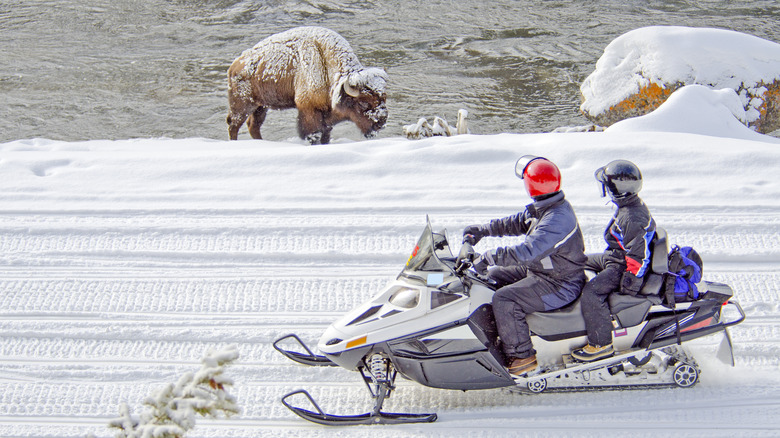National Park Service Rangers' Crucial Advice About Visiting Yellowstone In The Winter
Yellowstone National Park is a destination that has long appealed to travelers looking to be awed by the beauty of nature, wildlife, and thrilling landscapes. The National Park Service reported over 3 million visitors to Yellowstone in 2022, with many arriving between the high travel months of June through September. If you're hoping to avoid the daunting crowds, planning a winter trip this way is always a good option. However, National Park Service rangers want travelers to be aware of several necessary precautions before heading here in the winter to ensure safe experiences as they explore in this unpredictable season.
Rangers are reminding winter travelers that it's important to have the National Park Service app downloaded on your phone before you arrive. It's a one-stop resource for updated weather conditions at the park so you can adjust your plans and routes accordingly. There's a good chance you'll have to do exactly that at some point during your winter getaway. The park typically gets around 150 inches of snowfall annually, with numbers jumping between 200 and 400 inches in higher elevation areas. Downloading the app is just one of many steps to take to protect yourself when visiting Yellowstone in the wintertime.
Prepare for cold, impressive snowfall, and adventure
The unpredictable weather that defines a winter trip to Yellowstone National Park often includes some seriously cold temperatures that visitors will want to be prepared to encounter. It's not uncommon for daily highs this time of year to not rise above 0 to 20 degrees Fahrenheit. This makes having the right outdoor apparel vital, whether your plans include hiking, snowshoeing, cross-country skiing, or ice climbing. It's just as essential to be sure you have extra food, water, and blankets in your car in case plummeting temperatures and snowfall have your vehicle performing less than optimally as you explore.
Once fully fueled on gas, make your way to the park's north gate in Gardiner, Montana, the only entrance to Yellowstone open in the wintertime. This is your primary access point to enjoying the seasonal wonderland that typically includes frosted trees, steamy thermal vents, and opportunities to watch wildlife trek through snowy landscapes. Do keep in mind that if you visit the iconic Old Faithful Geyser or Yellowstone's very own Grand Canyon, you'll only be able to do so in winter by booking a tour or having a snowmobile permit in hand before your arrival. Those 18 and older can apply for a permit of this type through the Non-Commercially Guided Snowmobile Access Program, which works as a lottery. Applications are accepted throughout August, with permits awarded by mid-September each year.
Take special precautions at hot springs and with wildlife
A highlight activity for many travelers making their way to Yellowstone is the chance to observe a colorful hot spring or two. Winter is a particularly scenic time to enjoy this view as the colors stand out vividly against a white, snowy backdrop. As appealing as the experience is, it's extremely important to stick to the designated viewing boardwalks, especially this time of year when ice and snow are involved. With temperatures at the famed Norris Geyser Basin reaching upward of 459 degrees Fahrenheit, there's certainly no room for error.
Winter is hibernation season for Yellowstone bears, but that doesn't guarantee there won't be a few out and about roaming alongside wolves, bison, elk, coyotes, and more. As you're exploring, be sure you have bear spray readily available and have taken the time to learn how to use it properly. If you're looking forward to spending time photographing wildlife during your winter visit, a zoom lens is highly recommended. Park rules indicate visitors must stay at least 100 yards away from bears and wolves and 25 yards from other wildlife. It's also important to throw any trash you might accumulate during your visit into the designated bear-proof trash receptacles throughout the park. These are specifically designed to protect local wildlife and help maintain a safe distance between people and animals in all seasons.


